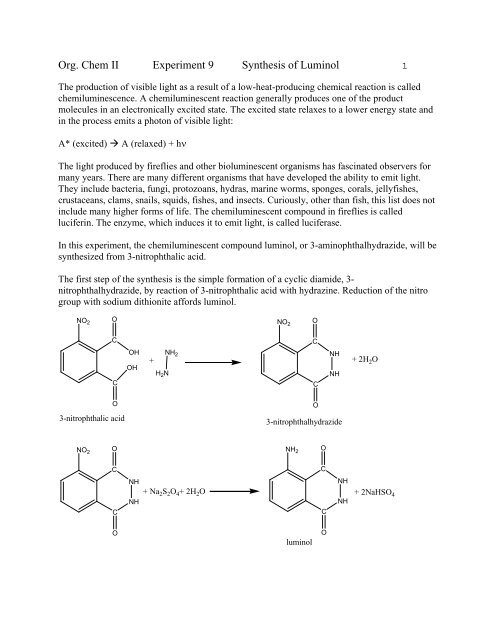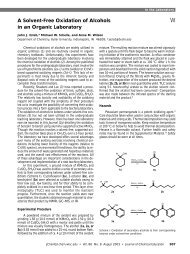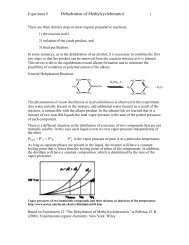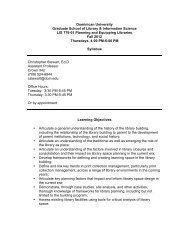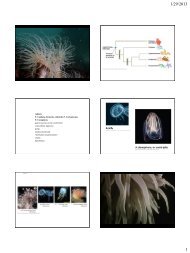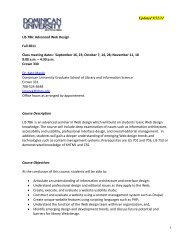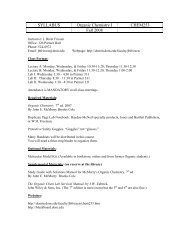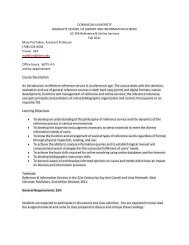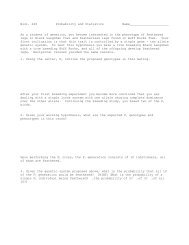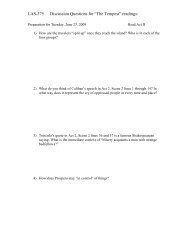Org. Chem II Experiment 9 Synthesis of Luminol - OChemOnline
Org. Chem II Experiment 9 Synthesis of Luminol - OChemOnline
Org. Chem II Experiment 9 Synthesis of Luminol - OChemOnline
Create successful ePaper yourself
Turn your PDF publications into a flip-book with our unique Google optimized e-Paper software.
<strong>Org</strong>. <strong>Chem</strong> <strong>II</strong> <strong>Experiment</strong> 9 <strong>Synthesis</strong> <strong>of</strong> <strong>Luminol</strong> 1<br />
The production <strong>of</strong> visible light as a result <strong>of</strong> a low-heat-producing chemical reaction is called<br />
chemiluminescence. A chemiluminescent reaction generally produces one <strong>of</strong> the product<br />
molecules in an electronically excited state. The excited state relaxes to a lower energy state and<br />
in the process emits a photon <strong>of</strong> visible light:<br />
A* (excited) A (relaxed) + hν<br />
The light produced by fireflies and other bioluminescent organisms has fascinated observers for<br />
many years. There are many different organisms that have developed the ability to emit light.<br />
They include bacteria, fungi, protozoans, hydras, marine worms, sponges, corals, jellyfishes,<br />
crustaceans, clams, snails, squids, fishes, and insects. Curiously, other than fish, this list does not<br />
include many higher forms <strong>of</strong> life. The chemiluminescent compound in fireflies is called<br />
luciferin. The enzyme, which induces it to emit light, is called luciferase.<br />
In this experiment, the chemiluminescent compound luminol, or 3-aminophthalhydrazide, will be<br />
synthesized from 3-nitrophthalic acid.<br />
The first step <strong>of</strong> the synthesis is the simple formation <strong>of</strong> a cyclic diamide, 3-<br />
nitrophthalhydrazide, by reaction <strong>of</strong> 3-nitrophthalic acid with hydrazine. Reduction <strong>of</strong> the nitro<br />
group with sodium dithionite affords luminol.<br />
NO 2<br />
O<br />
NO 2<br />
O<br />
C<br />
C<br />
OH<br />
OH<br />
+<br />
H 2 N<br />
NH 2<br />
C<br />
C<br />
NH<br />
NH<br />
+ 2H 2 O<br />
O<br />
3-nitrophthalic acid<br />
O<br />
3-nitrophthalhydrazide<br />
NO 2<br />
O<br />
NH 2<br />
O<br />
C<br />
C<br />
C<br />
NH<br />
NH<br />
+ Na 2 S 2 O 4 + 2H 2 O<br />
C<br />
NH<br />
NH<br />
+ 2NaHSO 4<br />
O<br />
luminol<br />
O
<strong>Org</strong>. <strong>Chem</strong> <strong>II</strong> <strong>Experiment</strong> 9 <strong>Synthesis</strong> <strong>of</strong> <strong>Luminol</strong> 2<br />
In neutral solution, luminol exists largely as a dipolar ion (zwitterion). This dipolar ion exhibits a<br />
blue fluorescence after being exposed to light. However, in alkaline solution, luminol is<br />
converted into its dianion.<br />
NH 3<br />
O<br />
NH 2<br />
O<br />
C<br />
C<br />
N<br />
NH<br />
C<br />
N<br />
+ 2 OH + H 2 O<br />
N<br />
C<br />
luminol<br />
O<br />
O<br />
The dianion <strong>of</strong> luminol undergoes a reaction with molecular oxygen to form peroxide <strong>of</strong><br />
unknown structure. This peroxide is unstable and decomposes with the evolution <strong>of</strong> nitrogen gas,<br />
producing the 3-aminophthalate dianion in an electronically excited state.<br />
NH 2<br />
O<br />
NH 2<br />
O<br />
*<br />
C<br />
C<br />
N<br />
N<br />
C<br />
O<br />
+ O ? 2<br />
+ N 2<br />
O<br />
C<br />
O<br />
O<br />
The excited dianion emits a photon, which is observed as visible light.<br />
NH 2 O<br />
*<br />
NH 2 O<br />
C<br />
O<br />
O<br />
C<br />
O<br />
O<br />
+ hν<br />
C<br />
C<br />
O<br />
O<br />
http://www.metnet.state.mt.us/Special/Natives%20Are%20Nice/HTM/gifs/firefly.gif
<strong>Org</strong>. <strong>Chem</strong> <strong>II</strong> <strong>Experiment</strong> 9 <strong>Synthesis</strong> <strong>of</strong> <strong>Luminol</strong> 3<br />
Procedure:<br />
Part I<br />
3-nitrophthalhydrazide:<br />
Place 1.3 g <strong>of</strong> 3-nitrophthalic acid and 2 mL <strong>of</strong> a 10% aqueous solution <strong>of</strong> hydrazine in a large<br />
test tube. At the same time, heat at least 20 mL <strong>of</strong> water in a beaker. Clamp the test tube to your<br />
ring stand. Heat the test tube over a microburner until the solid dissolves. Add 4 ml <strong>of</strong> triethylene<br />
glycol to the test tube. Add a boiling stone to the test tube.<br />
Monitor the heat by placing your 250° C thermometer in the test tube held in place by a split<br />
stopper and/or a clamp. The bulb <strong>of</strong> the thermometer should be immersed in the solution without<br />
touching the glass. Heat the solution with a micro burner (the small one) until the liquid boils<br />
vigorously (the temperature will rise to about 120° C). Continue heating and allow the<br />
temperature to increase rapidly until it rises above 200° C. About five minutes will be required<br />
for this heating. Remove the burner briefly when the temperature 200° C has been achieved, and<br />
then resume gentle heating in order to maintain a fairly constant temperature <strong>of</strong> 210° to 220° for<br />
about two minutes. Be careful, this tends to boil over!<br />
Allow the test tube to cool to about 100°. Add the 20 mL <strong>of</strong> hot water which was prepared<br />
previously. Cool the test tube to room temperature. Collect the crystals <strong>of</strong> 3-nitrophthalhydrazide<br />
by vacuum filtration using a Hirsch (small porcelain) funnel. Use a piece <strong>of</strong> filter paper that<br />
covers only the bottom <strong>of</strong> the Hirsch funnel. It is not necessary to dry the product thoroughly in<br />
order to proceed with the next reaction step.<br />
<strong>Luminol</strong>:<br />
Part <strong>II</strong>.<br />
Transfer the 3-nitrophthalhydrazide back to the large side-arm test tube. Add 6.5 mL <strong>of</strong> a 10%<br />
sodium hydroxide solution, and stir the mixture until the hydrazide dissolves. Add 4 g <strong>of</strong> sodium<br />
dithionite (sodium hydrosulfite). Using a pipet, add about 10 mL <strong>of</strong> water to wash the solid from<br />
the walls <strong>of</strong> the test tube. Heat the test tube with a microburner until the solution boils. Stir the<br />
solution with a long glass rod. (Do not stir with a thermometer.) Maintain the boiling, with<br />
stirring, for 5 minutes. Add 2.6 mL <strong>of</strong> glacial acetic acid.<br />
Cool the test tube to room temperature. Stir the mixture during this cooling step. Finally, cool the<br />
solution in an ice bath. Collect the crystals <strong>of</strong> luminol by vacuum filtration using a Hirsch funnel.<br />
The luminol may be used without thorough drying for the chemiluminescence experiments.<br />
Adapted from <strong>Experiment</strong> 48: <strong>Luminol</strong>, in Pavia, Lampman and Kriz, “Introduction to <strong>Org</strong>anic<br />
Laboratory Techniques: A Contemporary Approach” (1976) Saunders
<strong>Org</strong>. <strong>Chem</strong> <strong>II</strong> <strong>Experiment</strong> 9 <strong>Synthesis</strong> <strong>of</strong> <strong>Luminol</strong> 4<br />
<strong>Chem</strong>iluminescence experiments:<br />
Part <strong>II</strong>I.<br />
Cover the bottom <strong>of</strong> a 250 mL Erlenmeyer flask with a layer <strong>of</strong> KOH pellets. Add about 25 mL<br />
<strong>of</strong> dimethylsulfoxide (DMSO) and your luminol to the flask. Stopper it with a rubber stopper and<br />
shake it vigorously to mix air into the solution. In a dark room a faint glow <strong>of</strong> light will be<br />
observed. The intensity <strong>of</strong> the glow will increase with continued shaking <strong>of</strong> the flask and<br />
occasional removal <strong>of</strong> the stopper to admit more air.<br />
Clean Up: Dispose <strong>of</strong> any waste in a properly labeled containers in the fume hood.<br />
____ Title and date<br />
____ Purpose.<br />
Checklist for completing the "Prelab" section:<br />
(refer to Laboratory Syllabus for complete directions)<br />
____ Physical constants. Create a table <strong>of</strong> physical constants and safety data for all chemicals<br />
and solutions referred to in the lab handout.<br />
http://domin.dom.edu/faculty/jbfriese/chem254/chemical.htm<br />
Structures and equations:<br />
____ Write the balanced equation (with structural formlas) for the overall reaction <strong>of</strong><br />
3-nitrophthalic acid to luminol.<br />
____ Draw the structures <strong>of</strong> triethylene glycol, sodium dithionite and DMSO<br />
___ Flowchart. Refer to "Procedure" Reference any sources you use.<br />
Calculations.<br />
1.) How many moles are in 1.3 g <strong>of</strong> 3-nitrophthalic acid?<br />
2.) If 3-nitrophthalic acid is the limiting reagent, what is the theoretical yield <strong>of</strong> luminol?<br />
3.) Calculate the atom economy <strong>of</strong> the balanced reaction <strong>of</strong> 3-nitrophthalic acid to luminol.<br />
Show your calculations please.<br />
Safety Question:<br />
What are the four ways a poison can enter your body?<br />
Give one example how each <strong>of</strong> these might (accidentally) happen in a chemistry lab.
<strong>Org</strong>. <strong>Chem</strong> <strong>II</strong> <strong>Experiment</strong> 9 <strong>Synthesis</strong> <strong>of</strong> <strong>Luminol</strong> 5<br />
<strong>Experiment</strong>al Observations and Data:<br />
Hand in a copy <strong>of</strong> your experimental observations and data before you leave lab.<br />
<strong>Experiment</strong>al Observations: Refer to Laboratory Syllabus for guidelines.<br />
Raw Data: Refer to Laboratory Syllabus for guidelines.<br />
Discussion and Conclusion.<br />
Lab Report Checklist:<br />
_____ Name two other organisms besides the firefly (Pyractomena borealis) that produce light.<br />
Give common names and Latin binomial names <strong>of</strong> species. Reference your source(s).<br />
_____ Define and differentiate between a) luminescence, b) chemiluminescence, c) fluorescence,<br />
and d) phosphorescence. Reference any sources you use.<br />
_____ How does luminol detect the presence <strong>of</strong> blood? What component or property <strong>of</strong> blood<br />
does luminol detect?<br />
_____ What is (or would be) a practical application <strong>of</strong> chemiluminescence besides “glow sticks”<br />
and blood detection?<br />
The form <strong>of</strong> the living creatures was like the appearance<br />
<strong>of</strong> burning coals <strong>of</strong> fire and torches. Fire was moving<br />
back and forth between the living creatures; it was<br />
bright, with lightning coming out <strong>of</strong> it. The creatures<br />
were darting back and forth like flashes <strong>of</strong> lightning.<br />
Ezekiel 1:13,14
<strong>Org</strong>. <strong>Chem</strong> <strong>II</strong> <strong>Experiment</strong> 9 <strong>Synthesis</strong> <strong>of</strong> <strong>Luminol</strong> 6<br />
Name Formula M.W. m.p. o C b.p. o C Density g/mL<br />
g/mole<br />
3-nitrophthalic acid C 8 H 5 NO 6 211.13 213-216<br />
hydrazine N 2 H 4 32.05 2.0 113.5 1.0036<br />
triethylene glycol C 6 H 14 O 4 150.17 -7.2 285 1.1274<br />
10% sodium hydroxide NaOH 40.0 1M sol<br />
~4<br />
1M sol.<br />
~102<br />
1 M sol.<br />
~1.0<br />
sodium dithionite Na 2 O 4 S 2 174.11<br />
(Sodium Hydrosulfite)<br />
glacial acetic acid C 2 H 4 O 2 60.05 16.7 118 1.049<br />
potassium hydroxide KOH 56.11 About 360<br />
Dimethyl<br />
C 2 H 6 OS 78.14 18.45 189 1.100<br />
Sulfoxide (DMSO)<br />
luminol C 8 H 7 N 3 O 2 177.16 319-320<br />
Name Solubility Safety Information<br />
3-nitrophthalic soluble in water,<br />
Warning: irritating to skin, eyes and<br />
acid<br />
slightly soluble in alcohol<br />
mucous membranes. Avoid skin contact<br />
hydrazine<br />
triethylene glycol<br />
10% sodium<br />
hydroxide<br />
sodium dithionite<br />
Sodium<br />
Hydrosulfite<br />
glacial acetic acid<br />
potassium<br />
hydroxide<br />
Dimethyl<br />
sulfoxide<br />
<strong>Luminol</strong><br />
References:<br />
insoluble in nonpolar solvents<br />
Miscible with water<br />
Miscible with alcohol<br />
Slightly miscible in nonpolar<br />
Miscible with water<br />
Miscible with alcohol<br />
Slightly miscible in nonpolar<br />
soluble in water,<br />
soluble in alc,<br />
insoluble in nonpolar solvents<br />
Very soluble in water<br />
Slightly soluble in alcohol<br />
Insoluble in nonpolar solvents<br />
Miscible with water,<br />
Miscible with alcohol,<br />
some miscible with nonpolar solvents.<br />
Soluble in water<br />
Slighly soluble in alcohol<br />
Insoluble in nonpolar sovents<br />
Miscible with water,<br />
Miscible with alcohol,<br />
some miscible with nonpolar solvents.<br />
soluble in water,<br />
slightly soluble in alcohol<br />
insoluble in nonpolar solvents<br />
1) Merck Index, 11th ed.<br />
2) www.chemfinder.com<br />
3) Hazardous <strong>Chem</strong>ical Desk Reference, Lewis and Sax, 1987<br />
4) Aldrich catalog online<br />
Warning: Corrosive.<br />
Warning: Irritant Warning Explosive<br />
Danger: Carcinogen.<br />
Poison by intravenous route.<br />
Mild toxicity.<br />
Combustible.<br />
Warning: Corrosive<br />
Warning: irritating to skin, eyes and<br />
mucous membranes. Avoid skin contact<br />
Caution: Flammable Solid<br />
Corrosive!<br />
Moderately toxic by various routes.<br />
Moderate fire and explosion hazard.<br />
Danger: corrosive, Danger: caustic,<br />
hygroscopic, Poison,<br />
Irritant and corrosive to membranes.<br />
Skin and Eye Irritant.<br />
Teratogen.<br />
Moderately toxic.<br />
Warning: irritating to skin, eyes and<br />
mucous membranes. Avoid skin contact


